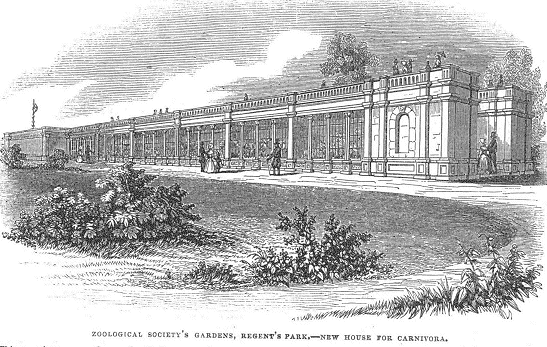 Today is the last day of the A to Z challenge and the final instalment of my series on the history of gardens. I’m starting this post by looking at menageries. Now hang on as I guide you to the reason why it’s my Z post.
Today is the last day of the A to Z challenge and the final instalment of my series on the history of gardens. I’m starting this post by looking at menageries. Now hang on as I guide you to the reason why it’s my Z post.
‘Menagerie’ was used in 17th century France to refer to the management of livestock or household, only later did it come to represent the aristocratic collection of animals or travelling collections found in circuses and fairs. For the aristocrats having exotic beasts on display was as good as publishing your bank balance and situating them inside pleasure gardens was an added bonus. William the First had a small menagerie, so did Henry I with lions and leopards. The Tower in London started collecting animals in 1204 displaying them in rows of cages. The menagerie was opened to the public in Elizabeth I’s reign and eventually the animals were moved in 1831 and the Tower menagerie was closed in 1835. What was created to house the animals was the London Zoological Garden, which is situated in Regents Park. It was initially called the Gardens and Menagerie of the Zoological Society of London. The abbreviation zoo was coined a few years later. London Zoo remains the oldest zoo in the world.

We’re all familiar with the animals kept at the zoo but probably less so when it comes to the garden or park aspect of a zoo. It’s something you might overlook when walking around – the flora. Paignton Zoo is a botanical garden where rare plants are displayed alongside rare animals. From cactus to giant water lilies, the zoo specialises in protecting plants species on endangered lists.

Bristol Zoo Gardens grow moth orchids from the Philippines, purple berried flax lily, acers and cedars. The gardens are laid out formally with flowering beds, and informally using rock gardens and sub-tropical displays. Edinburgh Zoo was originally a nursery owned by Thomas Blaikie who planted French parks and the horticulture tradition continues with 120 species of trees, and many plants grown in greenhouses.
The linking of plants to animals is also a big feature of zoological gardens, especially where micro-climates are created in tropical houses, and the plants augment the enclosures, showing off diversity and not simply the animals.

I live near Chester Zoo in the North West of England. It is not only home to thousands of animal and bird species, many of which are endangered, but also botanical gardens. There’s a sunken garden on the fringes of the zoo, tucked away where it’s quiet and peaceful and a great example of a water garden.

Then, there’s a Zen water garden planted with Chinese and Himalayan species; it’s right next door to the Red Panda enclosure.

Grasses, often neglected in formal gardens, are featured in the Madagascan Grasses where bamboo and sand dune grasses grow alongside ornamental grasses. The Andes garden is purposely built on a slope to mimic the habitats of the Chilean and Argentinian plants growing on the hillsides, and its next door to the butterfly garden.
Plants in zoos are used for windbreaks, shelter and shade for the animals, who in turn help pollinate when they brush against the flowers. Plants and animals go hand in hand, so its not surprising that zoos support the conversation of both with the creation of bee and insect gardens.

So when visiting a zoo, don’t forget to take in the landscape, the hard work of the gardeners who transform the spaces between the enclosures and create the habitats for the animals. It all adds to the experience, because after all, what would a garden be if it wasn’t for the visitors whether they are animals and humans.
Thanks to all the visitors who’ve stopped by and took the time to read my daily posts.










A delightful end to an interesting and informative series about one of my favourite pastimes, visiting gardens. Thank you.
My final Children’s Story – for now!
LikeLiked by 1 person
One of mine too! Thanks for all your comments.
LikeLiked by 1 person
Excellent point about plants and animals going together for both conservation and appreciation.
Congratulations on reaching Z!
Black and White: Z is for Ziz
LikeLiked by 1 person
Thanks for reading. I enjoyed writing the posts.
LikeLike
Congrats on finishing the challenge. I enjoyed the journey.
LikeLiked by 1 person
Thank you!
LikeLike
So many beautiful photographs (love the purple flax lily and the Zen water garden and the pink foot bridge), many that I have missed over the past month so I’ll be back to check out all of them.
Congratulations on completing the AtoZChallenge2019. Now it is time for some well-deserved extra zzzzz’s before tackling that next interesting project in May.
http://gail-baugniet.blogspot.com
Z is for Zulu Warrior in Belgium?
LikeLiked by 1 person
Thank you for stopping by. I hope you have the time to catch up on more posts. There’s so much reading still to be done!
LikeLike